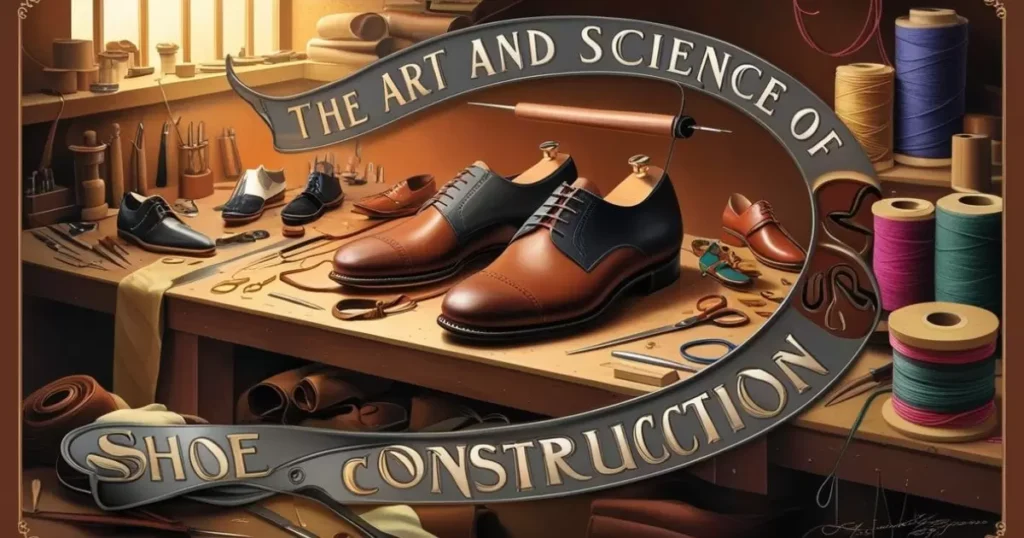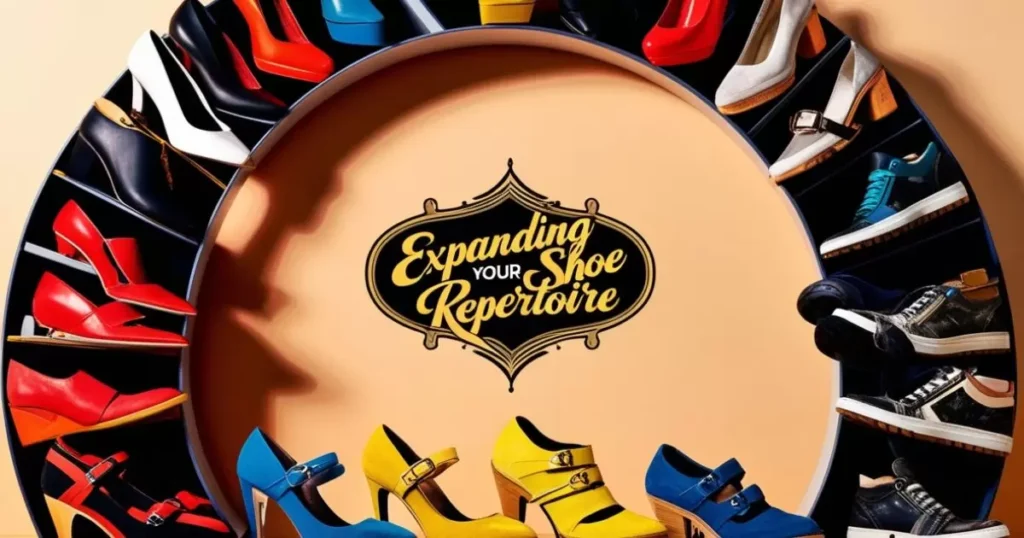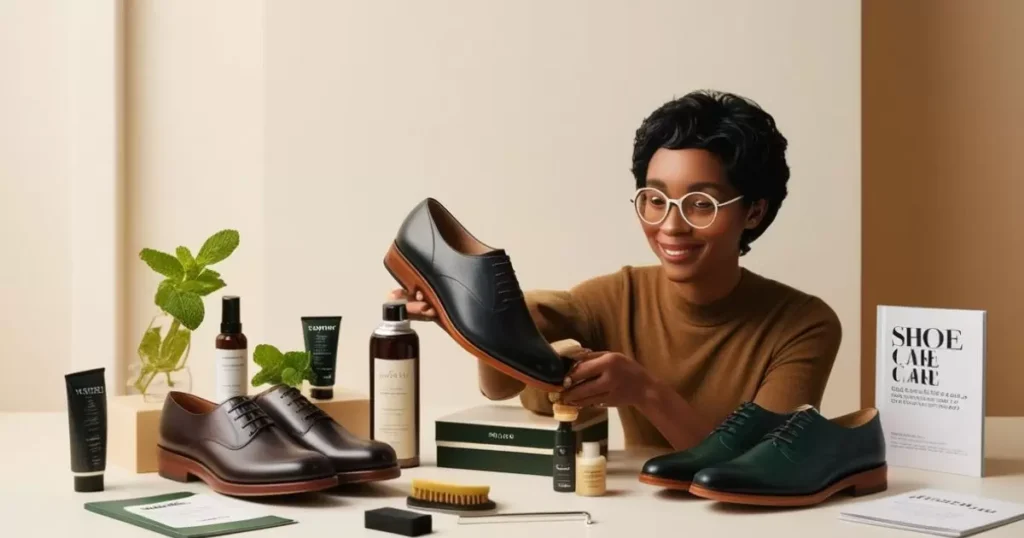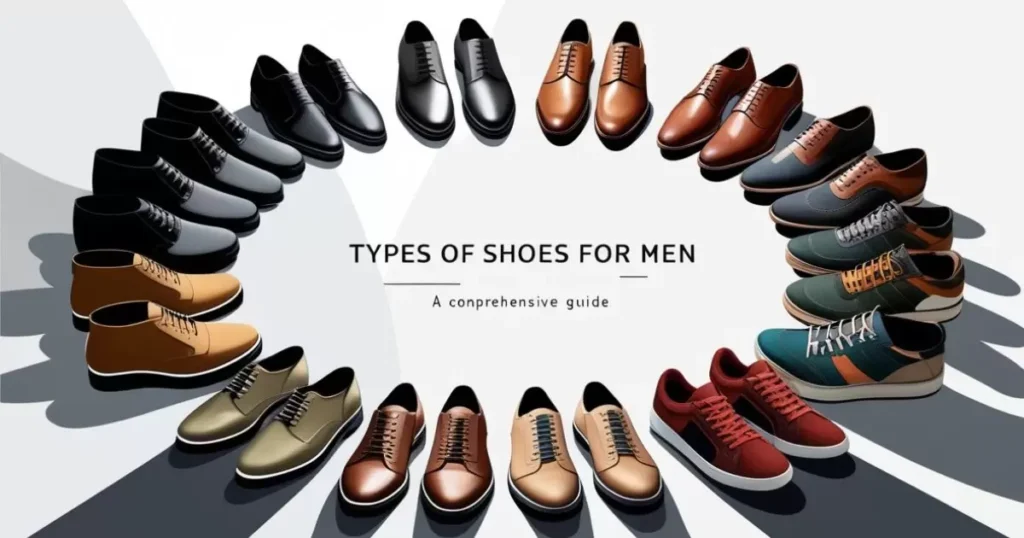In the world of men’s fashion, shoes are more than just a necessity – they’re a statement. Whether you’re closing a business deal, hitting the gym, or stepping out for a night on the town, your choice of footwear speaks volumes about your style, personality, and attention to detail. This comprehensive guide will walk you through the vast landscape of men’s shoes, helping you build a versatile collection that’ll keep you stepping in style for any occasion.
Introduction: The Sole of Style
Ever heard the saying, “You can judge a man by his shoes”? While we shouldn’t judge books by their covers, there’s a grain of truth here. Shoes are often one of the first things people notice about your outfit, and they can make or break your entire look.
The history of men’s footwear is as rich and varied as the styles available today. From the practical sandals of ancient civilizations to the elaborate court shoes of European royalty, men’s shoes have evolved to reflect changing tastes, technologies, and social norms.
“Give a girl the right shoes, and she can conquer the world.” – Marilyn Monroe
While Monroe was talking about women’s shoes, the same principle applies to men. The right pair of shoes can boost your confidence, complete your outfit, and help you put your best foot forward in any situation.
The Cornerstones of Men’s Footwear
Let’s dive into the main categories of men’s shoes, exploring the styles that should form the foundation of any well-rounded shoe collection.
Dress Shoes: Putting Your Best Foot Forward
Dress shoes are the backbone of a professional wardrobe. They’re designed to complement formal and semi-formal attire, projecting an air of sophistication and attention to detail.
- Oxfords: The timeless classic
- Closed lacing system
- Sleek, elegant profile
- Perfect for formal occasions and business settings
- Derbies: A versatile alternative
- Open lacing system
- Slightly more casual than Oxfords
- Great for business casual to semi-formal events
- Brogues: Adding flair to formality
- Characterized by decorative perforations
- Can be found in Oxford, Derby, or other styles
- Adds visual interest to formal and semi-formal looks
- Monk straps: Making a statement
- Fastened with buckles instead of laces
- Single or double strap options
- Bridges the gap between formal and casual
- Loafers: Slipping into sophistication
- Slip-on style without laces
- Penny, tassel, or horsebit variations
- Versatile from casual to business settings
Casual Kicks: Comfort Meets Style
For those off-duty days or relaxed work environments, casual shoes offer comfort without sacrificing style.
- Sneakers: From court to street
- Athletic origins, now a fashion staple
- Endless variety in designs and materials
- Perfect for casual outings and weekends
- Boat shoes: Nautical vibes on land
- Originated for use on slippery boat decks
- Typically made of leather with rubber soles
- Great for summer casual wear
- Moccasins: Laid-back luxury
- Inspired by Native American footwear
- Soft, flexible, and comfortable
- Ideal for lounging or casual errands
- Chukka boots: The casual-formal hybrid
- Ankle-high boots with two or three eyelets
- Often made of suede or leather
- Versatile for both casual and smart-casual outfits
- Slip-ons: Effortless cool
- Easy to put on and take off
- Various styles from casual to semi-formal
- Comfortable option for travel or everyday wear
Athletic Footwear: Form Follows Function
For the active man, having the right athletic shoes can make all the difference in performance and comfort.
- Running shoes: Built for speed and endurance
- Designed to absorb impact and provide support
- Lightweight materials for optimal performance
- Specific models for different running styles and terrains
- Cross-trainers: Jack-of-all-trades
- Versatile for various workout types
- Balance of support, flexibility, and cushioning
- Ideal for gym sessions and light sports activities
- Basketball shoes: High-tops and performance
- High-top design for ankle support
- Enhanced cushioning for jumps and quick movements
- Often feature bold designs and colors
- Soccer cleats: Grip and agility
- Studded soles for traction on grass
- Low-profile design for ball control
- Available in different stud configurations for various field types
- Tennis shoes: Court-ready comfort
- Designed for quick lateral movements
- Durable soles for hard court surfaces
- Often feature reinforced toe areas for slide protection
The Art and Science of Shoe Construction

Understanding how shoes are made can help you make informed decisions when investing in footwear. Let’s break down the key components and construction methods.
Materials that Matter
The choice of material significantly impacts a shoe’s appearance, durability, and comfort.
- Full-grain leather: The gold standard
- Highest quality leather
- Develops a beautiful patina over time
- Extremely durable and breathable
- Top-grain leather: A solid choice
- Second-highest quality leather
- More uniform appearance than full-grain
- Good balance of quality and affordability
- Suede and nubuck: Textured elegance
- Made from the underside of the animal hide
- Soft, velvety texture
- Requires more care to maintain appearance
- Canvas and synthetics: Lightweight options
- Affordable and often vegan-friendly
- Great for casual and athletic shoes
- Easy to clean but may be less durable
Sole Searching
The sole of a shoe plays a crucial role in comfort, durability, and functionality.
- Leather soles: Traditional craftsmanship
- Classic look for dress shoes
- Molds to your foot over time
- Less traction than rubber soles
- Rubber soles: Grip and durability
- Excellent traction in various conditions
- More water-resistant than leather
- Often used in casual and athletic shoes
- EVA and polyurethane: Cushioning comfort
- Lightweight and shock-absorbing
- Common in athletic and comfort shoes
- May compress over time with heavy use
- Cork: Natural shock absorption
- Often used as a midsole in dress shoes
- Molds to your foot for custom comfort
- Provides insulation in both hot and cold weather
Construction Methods
The way a shoe is put together affects its durability, comfort, and ability to be resoled.
- Goodyear welt: Built to last
- Strip of leather runs around the perimeter of the outsole
- Allows for easy resoling, extending shoe life
- Provides excellent water resistance
- Blake stitch: Sleek and flexible
- Stitching runs from the outsole directly to the insole
- Creates a slimmer profile than Goodyear welt
- Can be resoled, but the process is more challenging
- Cementing: Affordable and lightweight
- Outsole is glued directly to the upper
- Common in casual and athletic shoes
- Generally can’t be resoled, but keeps costs down
Expanding Your Shoe Repertoire

Beyond the basics, there are several other types of shoes that can add versatility to your wardrobe.
Boots: From Work to Weekends
Boots offer a perfect blend of style and functionality, suitable for various occasions and weather conditions.
- Chelsea boots: Sleek and sophisticated
- Ankle-high with elastic side panels
- Easy to slip on and off
- Versatile for both casual and formal wear
- Work boots: Rugged reliability
- Durable construction for tough conditions
- Often feature steel toes and slip-resistant soles
- Brands like Red Wing and Timberland are popular choices
- Desert boots: Casual versatility
- Ankle-high with suede uppers
- Crepe rubber soles for comfort
- Originated as military footwear, now a casual staple
- Hiking boots: Trail-ready toughness
- Designed for outdoor adventures
- Feature robust soles and waterproof materials
- Brands like Merrell and Salomon lead the pack
Sandals and Slides: Warm Weather Winners
When the temperature rises, it’s time to let your feet breathe.
- Leather sandals: Elevated casual
- More refined than flip-flops
- Great for resort wear or casual summer outings
- Brands like Birkenstock offer comfort and style
- Flip-flops: Beach essentials
- Simple design for ultimate casual wear
- Perfect for beach or pool
- Look for quality materials to avoid the “cheap” look
- Sport sandals: Adventure-ready
- Designed for outdoor activities
- Feature sturdy soles and secure straps
- Brands like Teva and Chaco are popular among outdoor enthusiasts
Specialty Footwear
For those occasions that call for something a little different.
- Dress boots: Formal with an edge
- Combine the elegance of dress shoes with the sturdiness of boots
- Great for fall and winter formal wear
- Brands like Alden and Allen Edmonds offer high-quality options
- Driving shoes: Behind the wheel comfort
- Flexible soles with rubber nubs for pedal grip
- Comfortable for long drives
- Can double as casual loafers
- Espadrilles: Mediterranean flair
- Canvas or cotton fabric uppers with a rope sole
- Perfect for beach vacations or summer casual wear
- Brands like TOMS have popularized this style
Mastering the Art of Shoe Selection
Choosing the right shoe for the occasion is an art form in itself. Here’s a guide to help you navigate different scenarios.
Dressing for the Occasion
- Business formal: Making power moves
- Stick to classic Oxford or Derby styles in black or dark brown
- Ensure shoes are well-polished and in excellent condition
- Avoid bulky or overly decorative styles
- Smart casual: Striking the right balance
- Loafers, brogues, or clean sneakers can work well
- Choose colors that complement your outfit
- Pay attention to the overall dress code of the event
- Weekend warrior: Comfort without compromise
- Sneakers, boat shoes, or casual boots are great options
- Consider the activities you’ll be doing
- Don’t be afraid to show some personality with colors or styles
- Black tie affairs: When only the best will do
- Patent leather Oxford shoes are the gold standard
- Always choose black for true black tie events
- Ensure shoes are impeccably polished and in perfect condition
Considering Your Lifestyle
- The city dweller: Navigating urban terrain
- Invest in comfortable yet stylish shoes for walking
- Consider versatile styles that can transition from day to night
- Look for durable soles that can handle city streets
- The outdoorsman: Ready for any adventure
- Prioritize sturdy hiking boots and water-resistant options
- Don’t neglect casual styles for downtime
- Consider trail runners for light hikes and everyday wear
- The athlete: Performance-driven choices
- Invest in sport-specific shoes for your preferred activities
- Don’t neglect recovery slides or sandals
- Look for versatile cross-trainers for general workouts
- The fashion-forward: Staying ahead of trends
- Follow fashion weeks and style influencers for inspiration
- Don’t be afraid to experiment with bold colors or unique designs
- Balance trendy pieces with classic styles for a well-rounded collection
Care and Maintenance: Extending Shoe Life

Proper care can significantly extend the life of your shoes, saving you money in the long run and keeping your footwear looking its best.
Essential care tools and products
- Shoe trees: Cedar shoe trees absorb moisture and help maintain shape
- Shoe brush: For removing dirt and applying polish
- Leather conditioner: Keeps leather soft and prevents cracking
- Polish: Restores shine and color to leather shoes
- Suede brush: Specially designed to clean and restore nap on suede shoes
Cleaning and polishing techniques
- Remove laces and insert shoe trees
- Brush off dirt and debris
- Apply leather cleaner or saddle soap if needed
- Condition the leather
- Apply polish in circular motions
- Buff to a shine with a clean cloth
Proper storage and rotation
- Use shoe trees when shoes are not being worn
- Allow at least 24 hours between wears to dry out completely
- Store in a cool, dry place away from direct sunlight
- Use dust bags for expensive or delicate shoes
- Rotate your shoes regularly to extend their life
Sustainability in Footwear
As environmental concerns become more pressing, many shoe manufacturers are stepping up to create more sustainable options.
Eco-friendly materials and production methods
- Recycled plastics: Many brands now use ocean plastics in their shoes
- Plant-based materials: Algae, cork, and bamboo are becoming popular alternatives
- Organic cotton and wool: Reduces the environmental impact of textile production
- Water-based adhesives: Less harmful than traditional solvent-based options
Brands leading the charge in sustainable shoes
- Allbirds: Known for their wool runners and tree-based fabrics
- Veja: Uses organic cotton and wild rubber in their sneakers
- Rothys: Creates shoes from recycled water bottles
- Vivobarefoot: Offers a re-commerce program for used shoes
The importance of quality and longevity
Investing in high-quality shoes that last longer is inherently more sustainable than buying cheap, disposable footwear. Look for shoes that can be resoled and repaired, and take good care of your shoes to extend their lifespan.
Conclusion: Putting Your Best Foot Forward
Building a versatile shoe collection is an investment in both style and comfort. By understanding the different types of shoes available, how they’re constructed, and how to care for them, you can make informed decisions that will serve you well for years to come.
Remember, quality often trumps quantity. It’s better to have a few pairs of well-made shoes that you love and that suit your lifestyle than a closet full of mediocre footwear.
Lastly, don’t be afraid to let your personal style shine through in your shoe choices. Whether you’re a classic dresser or a trendsetter, there’s a perfect pair of shoes out there for every occasion and every man. So step out in confidence, knowing you’re well-equipped to put your best foot forward, no matter where life takes you.
Frequently Asked Questions
1. Q: What are the essential types of shoes every man should own?
A: Every man should have dress shoes, sneakers, boots, loafers, and sandals in his wardrobe.
2. Q: Which type of men’s shoes are best for formal occasions?
A: Oxford or Derby dress shoes are ideal for formal events, with black or dark brown being the most versatile colors.
3. Q: What are the most comfortable types of shoes for men?
A: Sneakers, especially those with good cushioning and support, are typically the most comfortable shoes for men.
4. Q: Are there versatile shoe types that can be worn for both casual and semi-formal settings?
A: Yes, brogues and loafers are excellent options that can be dressed up or down depending on the occasion.
5. Q: What types of men’s shoes are trending in current fashion?
A: Currently, minimalist sneakers, Chelsea boots, and slip-on loafers are popular trends in men’s footwear.

An author is a creator of written content, producing works ranging from books and articles to blog posts and essays. They use their creativity, knowledge, and research to inform, entertain, or persuade readers. Authors often have a unique voice and perspective, contributing significantly to literature and various media.

